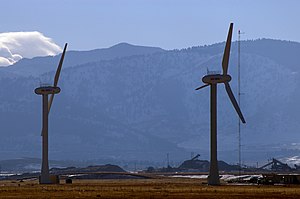
- Image via Wikipedia
Pretty well, once the technology to automatically respond to peak demand and store renewable energy matures
The heat wave in which much of the nation remains mired comes as a handful of communities across the country take their first steps toward implementing smart grid technology. The new meters, electricity distribution management systems, network management software and other technologies are designed to add intelligence to the way power is generated, distributed and used.
Already, smart grid pilot projects are up and running in places such as Harrisburg, Pa., Richland, Wash. (pdf), and Boulder, Colo.). As these regional smart grids expand, their eventual integration into a national smart grid should help make blackouts and brownouts (which of course can be devastating to a region’s health and economy) easier to avoid and could possibly lead to discounts on consumer electric bills, provided consumers do not mind handing over some control of their home meters and appliances to their utility companies.
However, regional smart grids will not be in place until long after this summer’s strings of consecutive above-90 degree Fahrenheit days are over—with adoption set to roll out over the next five years or so, provided consumers get on board. Still, the smart grid—which at its essence enables two-way communication of how electricity is generated, distributed and consumed—is expected to have a major impact on how we cope, energy-wise, with many long, hot summers to come, leveling peak demand for electricity with the help of smart appliances (including home chargers for the fleet of electric cars on the way) programmed to dial down energy usage when the grid is threatened with an overload.
Today, even without regional smart grids, utilities are able to cut energy consumption by businesses automatically through what are called demand response systems. These systems, usually arranged on a contractual basis, empower utilities to reduce the distribution of electricity to businesses that sign up for this service. This might include resetting a business’s air conditioning thermostat to a higher temperature (typically only a few degrees) if the utility is seeing too much demand on its network. In return, the business saves money on its energy bill. Such arrangements are expected to expand significantly, especially into the residential sector, as smart grid technology proliferates, says Steve Minnihan, a research associate with Lux Research Inc. in Boston.
Tough social contract
“The challenge is that we’ve been operating with an implied contract with users that no matter how much energy they need, the utility will provide it for them,” says Steve Hauser, vice president of grid integration at the U.S. Department of Energy’s National Renewable Energy Laboratory (NREL) in Golden, Colo. It has even gotten to the point where, if the utility is not able to meet consumers’ demand, the utility can be penalized. Expectations that utilities will keep their customers’ air conditioners running even during prolonged heat waves will not change, so power companies are seeking better ways to meet this demand, in part via smart grids.
The ability to offer demand response systems is in a more nascent stage for homes than it is for businesses because it requires homeowners to install smart meters, a key component of the smart grid infrastructure. Once these meters, which communicate directly with the utility company via a network, are installed, consumers will be able to get detailed information about the variable cost of electricity at different times of the day. The goal is to enable consumers to better manage their electricity usage and thereby save money. The utilities benefit by experiencing fewer sharp spikes in demand when, for instance, commuters get home from work and simultaneously turn on air conditioners, clothes dryers and dishwashers. Eventually, consumers may likewise be able to make contractual arrangements, as some businesses already do, to hand that management over to utility companies during heat waves and other extreme weather conditions.









